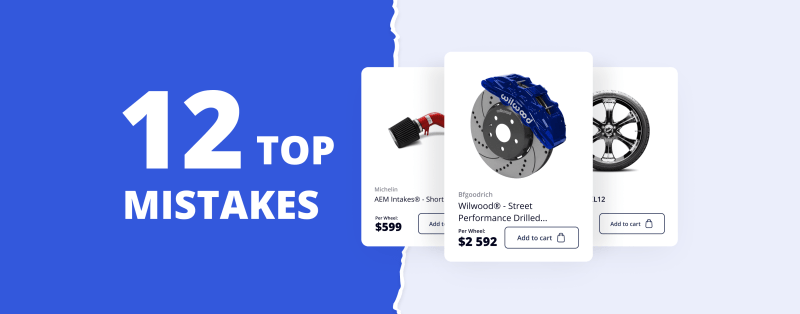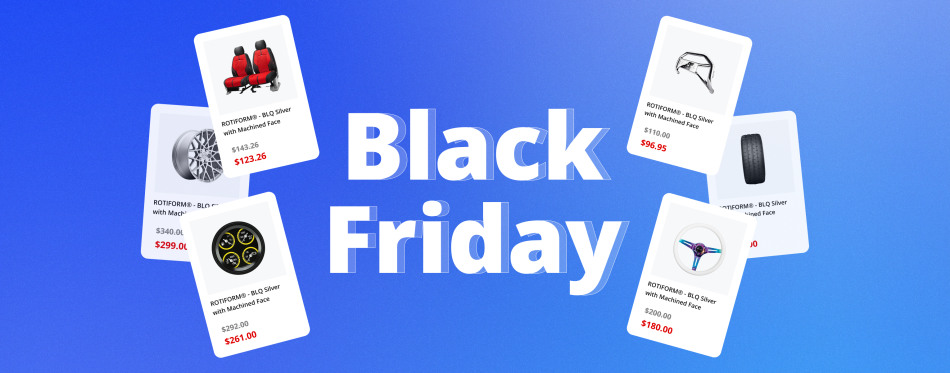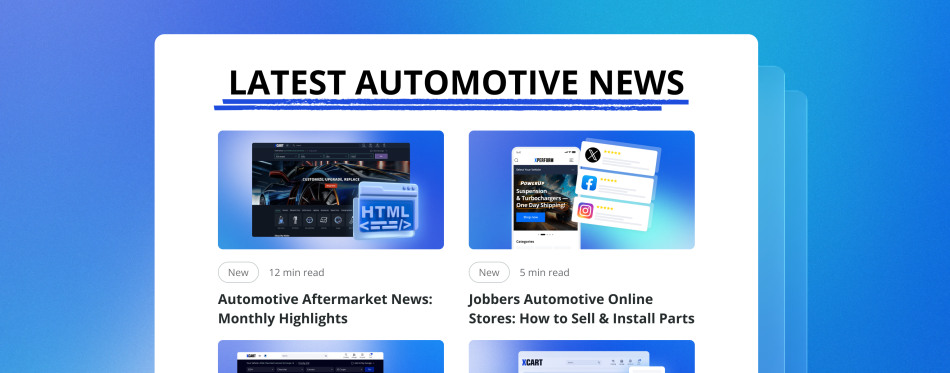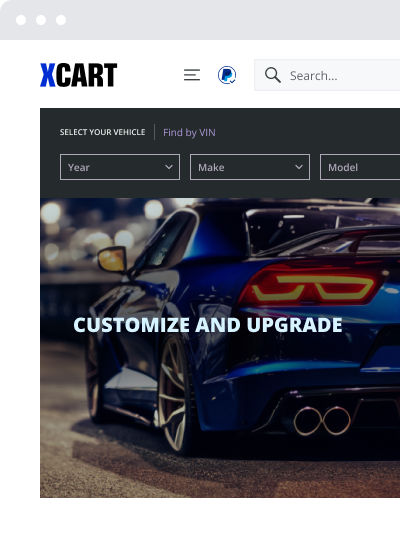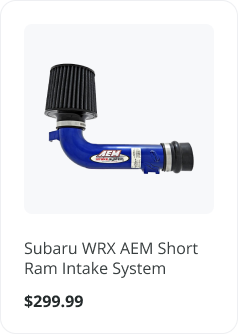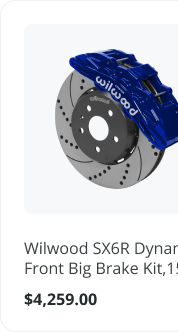12 Top eCommerce Mistakes to Avoid If You’re an Auto Parts Manufacturer
So, your auto parts manufacturing company has decided to enter the dynamic, lucrative, but occasionally challenging world of selling your automotive parts directly to end-consumers (D2C) or to businesses (B2B) through an enhanced online portal. This is a significant strategic move!
The online automotive aftermarket is a massive arena, with projected sales expected to reach $211.42 billion by 2029. That’s a substantial volume of components, your components, changing hands via the internet.
However, before you imagine new, easy sources of income, let’s discuss the ways your eCommerce endeavor can go awry, especially for a manufacturer. Some of the most common eCommerce mistakes, like underestimating the complexity of logistics and a lack of rich product descriptions, can render your digital storefront ineffective and even damage your brand. But we’re here to help you navigate these one by one!
1. Digital First Impression
Imagine a potential customer, be it a DIY enthusiast or a repair shop owner, searching for a specific, crucial part you manufacture. Picture this: a potential customer (maybe a hands-on DIYer or a busy shop owner) is searching for a specific part you make. They land on your official site, ready to buy.
But instead of a smooth experience, they’re met with an outdated design, clunky navigation, or a search bar that can’t even find a part number you know is in your catalog. That customer, understandably, loses confidence not just in the website, but potentially in your brand’s quality and attention to detail. They will quickly seek out a competitor (as 50% of customers leave a cluttered website) or a more user-friendly distributor.

It’s a common eCommerce mistake, and for manufacturers, it’s an even bigger problem: a poorly designed and user-unfriendly website. Today, your website, especially a direct sales channel, is a primary touchpoint for your brand. It’s your initial interaction, your sales presentation, and your customer service portal, all in one. A cumbersome, confusing, and visually unappealing site is more than unprofessional; it actively deters potential customers and directly impacts your reputation and market standing.
We’re discussing this in detail here: Automotive Customer Experience Tricks to Sell More Auto Parts
What distinguishes a user-friendly website from one that causes high bounce rates is not solely about aesthetics (though high-quality product images, sourced directly from your design and production, are vital). It’s about delivering a great user experience:
- Is your navigation intuitive?
- Can a customer locate what they need efficiently, using OEM part numbers, VIN lookups, or clear categorical browsing?
- Crucially, is your site mobile-friendly?
With over 59.8% of online purchases made on mobile devices, responsive design is not optional. Mechanics in a workshop might be using a tablet, or a DIYer might be looking up a part on their phone mid-repair. If your site isn’t optimized for these scenarios, you’re losing business that should be yours.
One thing you can control is choosing a user-centric and visually appealing eCommerce platform tailored to selling auto parts. X-Cart, for example, offers a range of customizable mobile-responsive design templates that reflect your brand’s quality and are built with the automotive industry’s specific needs in mind. This includes features that simplify the process for customers to find the exact part they require, directly from the source.
2. Will It Fit? Challenge
Selling general merchandise online has its challenges. Selling automotive parts online, as a manufacturer, carries an even greater responsibility for precision. If a customer orders a water pump you manufactured, based on your website’s information, and it doesn’t fit their 2018 Ford F-150, you’re facing more than a return. You’re dealing with a frustrated customer whose vehicle may be disassembled, leading to negative feedback that directly impacts your brand reputation, the very brand you’ve built on quality and precision engineering.
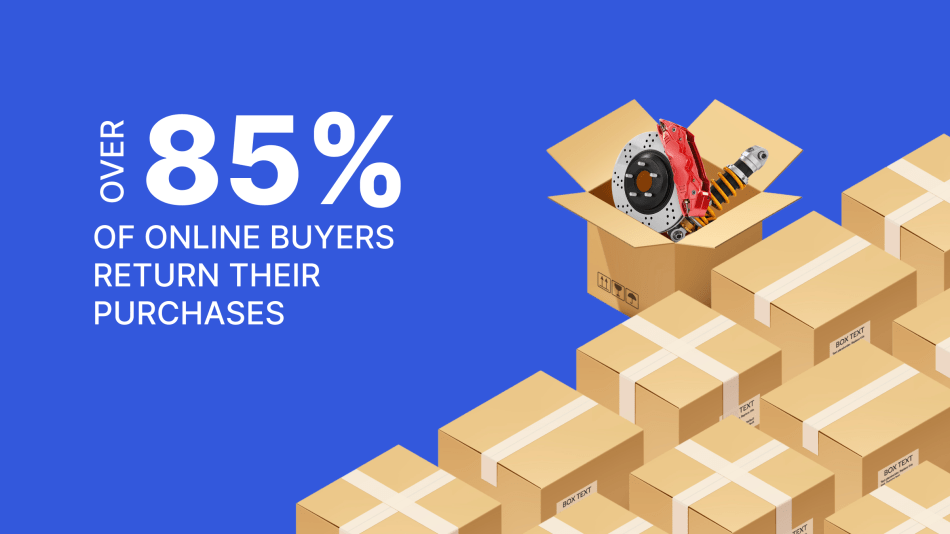
The immense complexity of automotive parts catalogs presents a significant hurdle, and as the manufacturer, you are the ultimate source of this information. Year, make, model lookup is merely the starting point. What about engine specifications, trim levels, VIN-specific parts, supercessions, or mid-year production changes? These are the most common eCommerce mistakes that can result in logistical problems and lost sales very fast.
Fix it: 9 Best YMM Search Tools Compared
Your product pages must offer more than a name and price. They need to be comprehensive, reliable sources of information, directly from your engineering and product teams. This means detailed product descriptions, precise specifications, and robust and constantly updated fitment details.
Generic platforms may struggle with the automotive parts industry’s demands. Unlike them, X-Cart is designed for this complexity, offering strong product information management capabilities. It allows manufacturers to manage and present complex product details and can facilitate seamless integrations with industry-standard fitment data providers (like ACES and PIES), ensuring the information your customers see is accurate and authoritative because it originates with you.
3. Subpar Product Images and Lack of Detail from the Source
Still on product pages, but let’s talk about visuals. As the manufacturer, you have access to CAD drawings, detailed schematics, and the parts themselves in pristine condition, so there’s no excuse for poor imagery. For automotive parts, customers often need to see what they’re buying, and not just a tiny, pixelated thumbnail. They need to compare it to the part they’re replacing, check connections, and visually confirm details.
One of the most common eCommerce mistakes is underestimating the power of high-quality product images and multiple viewing angles. If your product photos are blurry, poorly lit, or only show one side of a complex component you designed and built, you’re creating uncertainty and failing to showcase your product’s quality.
This uncertainty leads to hesitation and, often, a lost sale. Consider videos showcasing the part, 360-degree views, exploded diagrams from your own service manuals, or installation guides. These aren’t luxuries, but conversion tools that reinforce your brand’s expertise.
Avoid potential eCommerce mistakes with the right automotive eCommerce platform for manufacturers!
X-Cart understands this, too, allowing for multiple high-resolution images per product, zoom functionalities, and easy integration of rich media. The AutoSync visualizer for wheels and tires goes even further, as it allows visitors to adjust lift and other specific things and see what the tires would look like on their vehicle.
4. Balancing Production, Distributor Needs, and Direct Sales
Let’s say a customer successfully orders a set of high-performance brake rotors from your manufacturing website. Your website confirms the order and processes the payment. The issue is that those brake rotors, while in your inventory system, might be allocated for a large distributor order, or your production schedule doesn’t align with immediate D2C fulfillment. This situation is a prime example of how to erode customer trust and create channel conflict.
Ineffective inventory management is a frequent problem for online businesses, but for manufacturers, it has added layers of complexity. You need to align production planning, existing distribution commitments, and new D2C demand. It results in overselling to direct customers, leading to canceled orders, disappointed buyers, and a tarnished brand reputation. Conversely, excessive caution and ring-fencing too much stock for D2C can be inefficient.
Automation and integration are key here. Manually updating inventory levels across your internal ERP, your distributor portals, and your D2C website is prone to error. That’s why a robust inventory management system, integrated with your eCommerce platform and your core manufacturing systems, is essential.
X-Cart can provide powerful inventory management tools or integrate with your existing ERP systems, enabling real-time stock level tracking, low-stock alerts, and even management of inventory across multiple locations or channels. This helps prevent overselling, ensures customers receive their orders promptly, and allows manufacturers to manage D2C sales without disrupting their core business.
5. Overcomplicating the Payment Process for Your Direct Customers
You’ve guided a customer to your site, they’ve found the correct part (thanks to your excellent data!), and added it to their cart. The final step is imminent. And then… you present a checkout process that is excessively long and complex. The result is cart abandonment, even when they want to buy directly from the source.
The average cart abandonment rate is approximately 70%. A significant contributor to this is a lengthy and complicated checkout process. Your customers are ready to purchase, so it’s not a good idea to make it unnecessarily difficult, especially when they’ve chosen to buy from you, the original source.
Key principles for an effective checkout process are:
- Guest checkout: Do not mandate account creation. It’s a major deterrent for new buyers.
- Simplicity: Minimize the number of fields. Request only essential customer information.
- Multiple payment options: Offer a variety of secure payment options, including credit cards, PayPal, and other widely used digital wallets.
- Transparency: Clearly display shipping costs and taxes upfront. Surprises at the final stage are unwelcome.
A frictionless checkout process is vital for a successful D2C eCommerce business. X-Cart excels here, offering a clean, intuitive, and highly customizable checkout process that simplifies purchase completion.
6. The If You Build It, They Will Magically Appear Misconception
You’ve developed an excellent, user-friendly website. Your product details, direct from engineering, are accurate. Your inventory is well-managed between production and direct sales. Your checkout process is seamless. You launch your online store, anticipating a flood of orders from customers eager to buy direct. And then… silence.
This is a critical eCommerce mistake, especially for manufacturers who may traditionally rely on distributors and retailers for marketing to end-users: the build it and they will come fallacy. In the competitive online environment, mere existence, even as the OEM, is insufficient. You must actively market your online store to inform potential customers of your presence, the benefits of buying direct, and your offerings.
This requires a comprehensive digital marketing strategy, which might be a new discipline for your organization:
- Search Engine Optimization (SEO): Optimizing your site to rank highly in search engine results for relevant keywords, including your brand name, part numbers, and common problems your parts solve.
- Content marketing: Creating valuable content (blog posts, detailed installation guides from your engineers, videos showcasing product benefits and manufacturing quality) that attracts and engages your target audience.
- Email marketing: Building an email list (e.g., from warranty registrations or site sign-ups) and nurturing leads with targeted campaigns.
- Social media marketing: Engaging with your audience on relevant social media platforms, showcasing your brand’s innovation and customer successes.
- Paid advertising: Utilizing platforms like Google Ads and social media ads to drive targeted traffic, perhaps focusing on hard-to-find parts or promoting the advantages of genuine OEM parts.
This can seem daunting, but a powerful eCommerce platform can simplify your marketing efforts. X-Cart, for instance, is designed with SEO best practices, offering clean code and customizable meta tags. It also integrates with a wide array of marketing tools, from email platforms to social media management software, and provides analytics to understand customer behavior and refine marketing strategies, giving your manufacturing brand direct insights into consumer demand.
7. Neglecting Direct Customer Reviews and Social Proof
Customers are often investing significant money in parts that are critical to their vehicle’s performance and safety. One of the most common eCommerce mistakes manufacturers make is failing to leverage the power of customer reviews and social proof gathered directly. When potential customers see positive reviews from other buyers on your site, or user-generated content showing your parts in action, it builds credibility and reduces purchase anxiety.
Conversely, a lack of reviews, or worse, unaddressed negative reviews on your own platform, can be a major red flag. For a manufacturer, these direct reviews are also invaluable product feedback.
Encourage visitors to leave reviews on your D2C site. Showcase testimonials prominently. Feature user-generated content. This authentic feedback can be far more persuasive than any marketing copy. X-Cart allows for easy integration of review systems and display of customer feedback to build crucial trust and gather vital market intelligence.
8. A Confusing or Punitive Returns Process for Your Products
No matter how good your fitment data is, returns are an inevitable part of selling auto parts online, even for manufacturers. A customer might order the wrong part by mistake, or a part might be damaged in shipping. How you handle these situations says a lot about your business and commitment to customer satisfaction. A complicated, unclear, or overly strict returns process is a massive point of friction and a common eCommerce mistake. If customers fear a difficult return directly to the manufacturer, they simply won’t buy in the first place or will revert to distributors.
Your returns policy should be clear, easy to find, and fair. Offer a reasonable return window and make the process as painless as possible. Providing pre-paid shipping labels for incorrect or defective items (a direct reflection on your product or data) can significantly improve the customer experience. For manufacturers, analyzing return reasons provides critical information for quality control and product information improvement.
9. Lack of Manufacturer-Level Customer Support and Poor Communication
When a customer has a technical question about a part you designed and built, an issue with an order from your factory store, or needs help with a return, they expect timely and knowledgeable support directly from the source. Ignoring emails, having long phone hold times, or providing unhelpful canned responses are quick ways to lose customers and generate negative word-of-mouth. Especially in the complex automotive parts market, access to knowledgeable support from the manufacturer can be a key differentiator and a reason to buy direct.
Offer multiple channels for customer support (email, phone, live chat). Ensure your support team is well-trained on your products (perhaps even including access to your engineering teams for complex queries) and empowered to solve problems. Proactive communication, such as order confirmation emails, shipping updates, and follow-up emails, also enhances the customer experience.
10. Ignoring Direct Sales Data and Analytics
Your D2C eCommerce store generates a wealth of information:
- website traffic
- bounce rates
- conversion rates
- popular products
- customer demographics
- cart abandonment reasons, and much more
Ignoring this direct-from-consumer data is a missed opportunity for manufacturers. This data can inform product development, identify regional demand variations, and highlight areas for improvement in your products or information. This is a surprisingly common eCommerce mistake.
Regularly analyze your D2C data to understand consumer behavior, identify pain points in the shopping journey, and optimize your marketing efforts and even your product strategies:
- Which product pages have the highest bounce rates?
- Where are customers dropping off in the checkout process?
- Which marketing channels are driving the most direct sales?
Tools like Google Analytics, when integrated with your eCommerce platform, provide invaluable insights.
11. Underestimating D2C Logistics Complexity and Costs
Automotive parts come in all shapes and sizes. Some are small and light; others are bulky, heavy, and fragile. As a manufacturer, your logistics are likely optimized for bulk shipments to distributors. Accurately calculating shipping costs for individual consumer orders and ensuring parts arrive undamaged can be a new logistical nightmare.
Underestimating D2C shipping complexity, offering “free shipping” without fully understanding the individual fulfillment costs, or using inadequate packaging for single items are common eCommerce mistakes that can decimate your profit margins or lead to damaged goods and unhappy customers.
You need robust D2C shipping solutions. This means integrating with multiple carriers, offering various shipping options (standard, expedited), calculating real-time shipping rates, and investing in proper packaging materials suitable for individual shipments. For oversized or freight items, specialized consumer-facing solutions are necessary.
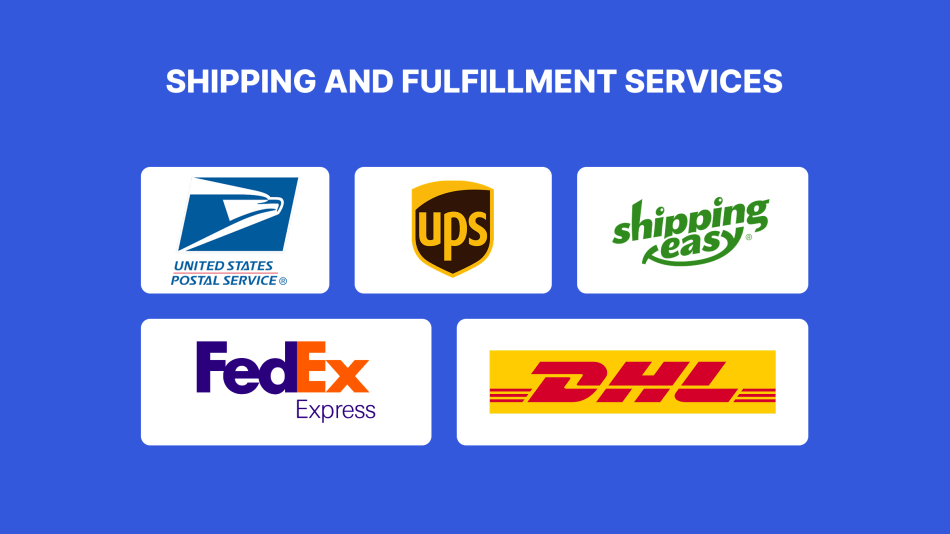
X-Cart integrates with a wide range of shipping providers and offers tools to configure complex shipping rules, helping manufacturers manage this critical aspect of their D2C business more effectively.
12. Channel Conflict
Finally, a major pitfall unique to manufacturers selling online is the potential for channel conflict. If your D2C pricing significantly undercuts your established distributors and retailers, or if you prioritize D2C stock over fulfilling distributor orders, you risk alienating valuable partners who have been crucial to your market reach. This requires a carefully considered strategy for pricing, inventory allocation, and communication with your existing sales channels.
Your D2C presence should ideally complement, not cannibalize, your traditional channels. Some manufacturers use their D2C site for specialized parts, to gather market details, or as a brand-building exercise, rather than purely as a high-volume sales channel in direct competition with partners.
Building More Than a Parts Store – Building a Direct Brand Connection
The online automotive parts market is challenging but offers immense potential for manufacturers. If you’re prepared to make an investment thoughtfully, develop new capabilities, and avoid these common eCommerce mistakes, the rewards can be substantial. You have an opportunity to build a direct connection with your end-users, foster a community, gain invaluable market insights, and cultivate a loyal customer base that relies on you, the manufacturer, for the quality and precision they expect.
It requires creating an excellent user experience, providing precise and comprehensive product information direct from the source, and simplifying the purchasing process. It means embracing data, actively marketing your brand directly to consumers, and providing outstanding customer support that reflects your manufacturing excellence.
With a robust and adaptable platform like X-Cart as a partner, automotive manufacturers gain the tools and support necessary to successfully navigate the complexities of D2C and B2B eCommerce and achieve their strategic business goals. The opportunity is there; approach it with diligence and the right tools tailored for a manufacturer’s unique position!
Avoid potential eCommerce mistakes with the right automotive eCommerce platform for manufacturers!
Frequently Asked Questions
How can we minimize errors when selling online?
This is a super common and valid concern. The key is to treat your fitment data as gold. Since you’re the manufacturer, you’re the ultimate source of truth. Ensure your engineering and product teams are heavily involved in providing and validating this information for your eCommerce platform. Use industry-standard formats like ACES and PIES if possible.
A specialized eCommerce platform, like X-Cart, is crucial here as it’s built to handle complex automotive data and can integrate with fitment databases. Regularly audit and update your information, especially for new models, mid-year changes, or part supersessions.
How can manufacturers avoid channel conflict?
When you go more than one way, consider how your D2C channel will operate:
- Will you offer exclusive parts not available through distributors or similar items?
- Will your pricing be structured to avoid direct undercutting?
Some manufacturers use their D2C site more for brand building, launching new innovations, or selling merchandise, rather than competing head-on for every part sale. Open communication with your distributors about your D2C strategy can also help alleviate concerns.
Perhaps you can even involve them in fulfillment for D2C orders in their regions. The goal is to make D2C a complementary channel, not a declaration of war on your existing partners.
Our company has always relied on distributors for marketing. What are the first steps a manufacturer should take to market a new D2C parts website?
It’s definitely a shift in mindset! Start by ensuring your own website is discoverable. This means focusing on Search Engine Optimization (SEO): using the right keywords (your brand name, part numbers, terms clients use to find your parts) so people can find you on Google.
Then, leverage your existing assets. Do you have an email list from warranty registrations? Use it! Create valuable content, like detailed installation guides (who knows your parts better than you?), videos showcasing the quality of your components, or blog posts about the technology behind your products. This builds trust and attracts organic traffic.
Paid advertising can also target specific customer segments looking for your parts. It’s about directly engaging with the end-users of your products.
We have a massive catalog of parts. How can we manage inventory effectively for both our distributor network and a new D2C channel?
This is where robust systems and complete integration are your best friends. Manually trying to juggle inventory across different channels with a large catalog is a recipe for disaster (overselling, stockouts, unhappy customers everywhere!). You’ll likely need an eCommerce platform that can either handle complex inventory logic itself or, more commonly for manufacturers, integrate deeply with your existing Enterprise Resource Planning (ERP) system.
This allows for real-time (or near real-time) synchronization of stock levels. You might designate certain stock for D2C, or have rules that prioritize orders based on channel or customer type. Automation is key to avoiding chaos and ensuring you can fulfill orders accurately, whether they come from a large distributor or an individual online buyer.
What’s the single most common mistake for manufacturers starting an online parts commerce?
That’s a tough one, as there are many! But if we had to pick one, it’s often the customer experience beyond the sale, particularly returns and customer support. Manufacturers are experts at making parts, but dealing directly with individual consumer queries, complaints, and returns at scale can be a whole new ballgame.
End consumers expect quick, easy returns and knowledgeable extra support, especially when buying from the “source.” Investing in a clear, fair returns policy and a well-trained customer support team (that can actually answer technical questions about your products) is crucial. This direct feedback loop, while challenging, can also provide invaluable insights for product improvement and quality control.
About the author

